The National Park Service (NPS) helps to preserve and protect powerful places — the physical memory of our nation's civil rights history. Some of these places have been established as units of the National Park System. Others have been listed in the National Register of Historic Places or designated as National Historic Landmarks. Still others are supported by various NPS Heritage Preservation programs.
Visiting these places - virtually or in person - allows us to form own connections to the history and stories of civil rights in America.
Preserve a Place
Do you know of sites and stories in your community connected to civil rights that need funding to be preserved?
- Park History Program
The Green Book: An Historic Context
- Offices: Park History Program

Traveling by car in the US with a minimum degree of safety and comfort is something we take for granted today. But not very long ago, this was not expected, and certainly not taken for granted, by a large percentage of African Americans. With the publication of the first Negro Motorist Green Book in 1936, however, African Americans were able to find safe places to visit and stay and to actively resist the discrimination they faced while traveling across America.
Places
- Selma To Montgomery National Historic Trail
Alabama: Selma to Montgomery National Historic Trail
- Locations: Selma To Montgomery National Historic Trail

On August 6, 1965, President Lyndon Johnson signed, the Voting Rights Act of 1965, which extended equal voting rights for African-Americans. As both White and Black non-violent supporters led by Dr. Martin Luther King Jr. fought for the right to vote in Central Alabama, today, you can trace their march toward freedom on the 54-mile trail and connect with their stories at the Interpretive Centers.
- Tuskegee Airmen National Historic Site
Alabama: Tuskegee Airmen National Historic Site
- Locations: Tuskegee Airmen National Historic Site

Before the first African American military pilots became known as the "Red Tails" they wore striped tails as they began their flight training in the Army's PT-17 Stearman bi-plane. Their flying adventure started in Tuskegee, Alabama and led them to the skies over Europe to help fight the Axis in WWII. Their story is immortalized in the National Historic Site that bears their nickname, the "Tuskegee Airmen."
- Locations: Booker T Washington National Monument, Tuskegee Airmen National Historic Site, Tuskegee Institute National Historic Site

In 1881, Booker T. Washington arrived in Alabama and started building Tuskegee Institute both in reputation and literally brick by brick. He recruited the best and the brightest to come and teach here including George Washington Carver who arrived in 1896. Carver’s innovations in agriculture, especially with peanuts, expanded Tuskegee’s standing throughout the country. The story continues….
- Offices: National Register of Historic Places Program

Listed in the National Register of Historic Places in 2020, All Souls Church, Unitarian has a rich architectural and social history. From the Civil War when it sought to define itself by its anti-slavery agenda, to more firmly establishing itself as a church with a social justice agenda during the civil rights era and finally to embracing its role as a “Welcoming Congregation,” All Souls has been in the forefront of the city and nation’s social issues.
- Locations: Brown v. Board of Education National Historical Park, Little Rock Central High School National Historic Site

The Bayard Rustin Residence is significant as the most important resource associated with Bayard Rustin (1912- 1987), a person of great importance in American political and social history. Born in West Chester, Pennsylvania, Rustin lived a peripatetic life as a social activist and organizer, living intermittently in a number of different homes. In 1962, Rustin purchased apartment 9J in Building 7 of the new Penn South Complex in the West Chelsea section of Manhattan.
- Booker T Washington National Monument
Booker T. Washington National Historic Site
- Boston African American National Historic Site
Boston African American National Historic Site
- Offices: National Register of Historic Places Program

The Bricklayers Hall, at 530 South Union Street in Montgomery, Alabama is a two-story, flat-roofed, brick office building and union hall. It was listed in the National Register of Historic Places in 2020 for its association with the Montgomery Improvement Association (MIA). The MIA achieved national significance during the 381-day Montgomery Bus Boycott that began in early December 1955.
Last updated: February 21, 2025




